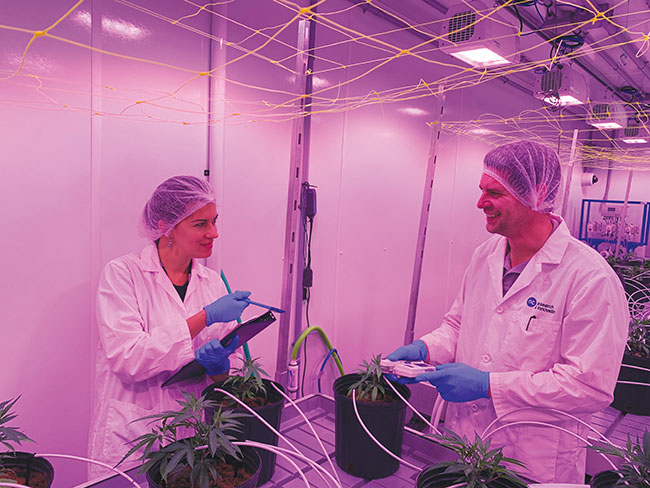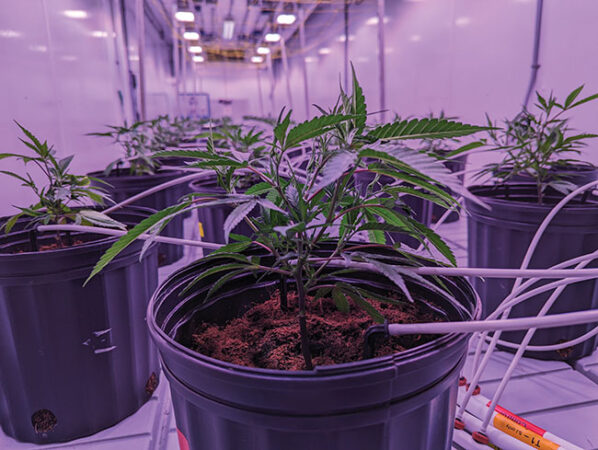
Features
Inputs
The search for novelty soil amendments
Exploring new ways to bring joy to plants and the planet
December 11, 2023 By Olga Safonova
 Scott Golem, Research Lead, and Gabriela Torrens, Research Associate, from the Horticultural & Environmental Sciences Innovation Centre collecting data for the Seaborn Organics “squid juice” trial in the Cannabis Indoor Cultivation Research Labs (Cannabunker) at the Daniel J. Patterson campus in Niagara-on-the-Lake.
Photos: Horticultural & Environmental Sciences Innovation Centre, Niagara College
Scott Golem, Research Lead, and Gabriela Torrens, Research Associate, from the Horticultural & Environmental Sciences Innovation Centre collecting data for the Seaborn Organics “squid juice” trial in the Cannabis Indoor Cultivation Research Labs (Cannabunker) at the Daniel J. Patterson campus in Niagara-on-the-Lake.
Photos: Horticultural & Environmental Sciences Innovation Centre, Niagara College What makes good soil? Every grower knows its basic properties: apart from mechanical support of a plant, good soil stores nutrients, ensures air and water movement, and provides a home for beneficial microorganisms. Soil structure can be improved by adding organic or inorganic amendments. While the organic portion makes up only about thre per cent of most natural soils, well-amended garden soil may contain 30 per cent or more organic matter. The most common organic amendments, such as compost and manure, have been around for ages. With increasing interest in organic products and sustainability in agriculture, the search for new ways of farming is on the rise. Organic additives, like fish compost, blood meal, biochar, kelp, and worm castings, have become increasingly popular, but have you ever heard of such an exotic substance as Black Soldier fly frass?
Inorganic soil conditioners include sand, dolomite lime, gypsum, perlite, vermiculite, and the options continue to grow. Are you familiar with wollastonite rock dust, or Huplaso basalt? What about Squid Based Plant Nutrient (squid juice)? Yes, that’s right… squid juice.
Squid juice
Commercial squid fisheries generate a great deal of waste. By-products of squid processing include squid ink, pen, skin, milt, liver, and viscera, and comprise about 52 per cent of the total body weight. All this waste goes into landfill. A few squid fisheries in the U.S. came up with the idea of liquifying squid by-products and using the liquid as a fertilizer.
Application of hydrolyzed squid by-products as an organic fertilizer was approved by the United States Department of Agriculture in 2016, but only recently became available in Canada. Seaborn Organics, a company based in St. Catharines, Ont., offers liquid plant food derived from Loligo Squid caught in Rhode Island. The “squid juice” includes three primary plant nutrients: nitrogen, phosphorus and potassium (2-2-2), and a variety of micro-nutrients and amino acids. It can be added to soil at any stage of a growing cycle and lasts for a few months. The “squid juice” can be used in a conventional greenhouse and hydroponic systems, both indoor and outdoor. A few studies conducted in the U.S. found that “squid juice” promotes budding and blooming and improves plants vigour.
Seaborn Organics is a client of the Horticultural & Environmental Sciences Innovation Centre (HESIC) at Niagara College. Currently, the effectiveness of “squid juice” as a complete fertilizer is being tested by HESIC researchers on cannabis and vegetable crops. The team hopes to confirm that this product can improve quality and yield of the crops.

The setup for the Seaborn Organics “squid juice” trial in the Cannabis Indoor Cultivation Research Labs (Cannabunker) at the Daniel J. Patterson campus in Niagara-on-the-Lake.
Sheep wool
Another HESIC client has a research trial underway for study of another novel soil amendment – sheep wool. The owners of a sheep farm in Ayton, Ont., created a company, EcoWool Canada Inc. (EcoWool), that offers wool fertilizer pellets as a natural soil builder.
Did you know that all farm sheep are supposed to have a buzz cut every year? Regular sheep shearing is done for health reasons and yields thousands of tonnes of wool. However, only three per cent of Canada’s wool is suitable to make a sweater. Some of the shorn wool can be used for carpeting and insulation, but most of it ends up in a landfill. According to numerous publications in Europe, the wasted wool could be pelletized and applied as a fertilizer and soil conditioner. The pellets have nitrogen, phosphorus and potassium ratio 10-0-3, although decomposition of wool is slow process and could take a few months. The most remarkable quality of the wool pellets is the water retention which is 26 per cent higher than in peat moss. At the same time, when the pellets expand and break down, they leave space in the soil. This will increase the porosity of the soil creating an oxygen rich environment.
Currently, the HESIC team is in the middle of a trial designed to confirm the potential of sheep wool as a soil amendment in greenhouse crops. The research includes a few crops with different lengths of growth cycle. The plants will be tested on the quantity of biomass and quality of fruits. The trial will also answer the question about the optimal quantity of wool added to regular potting soil.
However, EcoWool sees their product not only as a new soil amendment, but also as a possible peat substitute. If the HESIC trial proves that wool pellets could be used as a component of a soilless media, it may become a big step toward sustainability in the greenhouse industry.
Peat moss
Sphagnum peat moss is the main ingredient of soilless potting mixes used in greenhouse production and indoor gardening. Peat moss is harvested from bogs and fens around the world, primarily in Canada and Russia. The demand on peat moss is growing, and so are scientists’ concerns about the negative impact of its production on the environment. According to Oregon State University, peat bogs contain more carbon than all the planet’s forests combined, even though bogs take up only five per cent of the earth’s surface. Peat excavation releases enormous amounts of CO2 into the atmosphere, a major greenhouse gas driving climate change. Harvesting of peat moss also destroys a native habitat essential to the survival of many animal species. In England, the sale of peat moss will be banned starting in 2024 because of environmental concerns.
Both studies of these projects are possible thanks to grants provided by the Federal Economic Development Agency for Southern Ontario (FedDev), and Applied Research and Technology Partnership Grants. The funds are received through Greenhouse Technology Network (GTN).
Olga Safonova is a Research Laboratory Technologist at the Horticultural & Environmental Sciences Innovation Centre, Niagara College.
Print this page